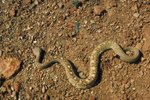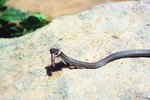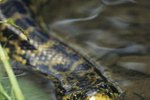
Snakes, like all animals -- including humans -- shed their skins. While humans shed skin cells in an ongoing process, to the tune of millions of tiny cells each day, snakes shed theirs all at once, two to four times a year. Several signs indicate when a snake is about to shed its skin, including inactivity.
Slows Down
The first sign that your snake is about to shed is when your normally active reptile begins to act lethargic or seems to hide. This period lasts from one to two weeks, until shedding starts in earnest. In the wild, snakes are more vulnerable during the shedding process, and pet snakes follow their instincts to hide. Provide your pet snake with privacy, and don’t handle him unless absolutely necessary. A scared snake can become an aggressive snake.
Blue-Eyed Snakes
During the period of decreased activity, a snakes eyes become dull and take on a blue hue. During shedding, snakes secrete a fluid to help separate the old skin from the new, and this fluid runs under his specialized eye caps, resulting in the opaque or blue quality of the eye. The snake’s vision is impaired at this point, another reason his activity level slows and he feels vulnerable. The eyes become clear again in about 7 to 15 days, and the snake starts actively rubbing against rough surfaces to aid him in removing the old skin.
Decreased Appetite
Along with decreased activity, snakes eat less when they begin to shed. Some snakes might eat in the very early phases of shedding, but most stop eating until their eyes become clear again. Still others won’t eat until their shed is complete.
Natural Brumation
In the wild, snakes brumate in cold weather. Brumation is the reptilian equivalent of hibernation. Depending on the temperature, an inactive snake might be getting ready to go into brumation. Because reptiles are ectothermic and cannot generate their own heat, in cold weather they seek out a warm, safe hiding place where their metabolism slows to the bare minimum. They don’t actually sleep, but they rest until the temperatures begin to warm again.
References
Photo Credits
-
Jupiterimages/Photos.com/Getty Images
Writer Bio
Leslie Darling has been a writer since 2003, writing regularly for "Mississippi Magazine" and "South Mississippi Living," specializing in food and wine, animals and pets, and all things Southern. She is a graduate of the University of New Orleans.




